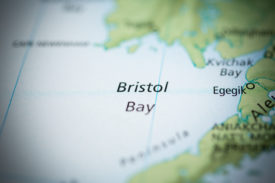 In allthe Northwest’sbig dailiestoday: the annual run of big spring Chinook are nowhere to be found on the Columbia River. Normally, by this time of year, roughly 3,100 King salmon have made their way past Bonneville Dam on the Lower Columbia—the vanguard of a run that can easily number a quarter million.
In allthe Northwest’sbig dailiestoday: the annual run of big spring Chinook are nowhere to be found on the Columbia River. Normally, by this time of year, roughly 3,100 King salmon have made their way past Bonneville Dam on the Lower Columbia—the vanguard of a run that can easily number a quarter million.
But this year so far, only 200 have arrived. It’s the worst early showing since the Bonneville Dam was constructed in 1938. (The last time it was close was 1952 when only 478 had arrived by now.) Scientists are unanimous about only one thing: they don’t know what’s wrong.
There are a dozen partial explanations in the offing: sea lion predation in the river is increasing, ocean conditions may have been bad for this run, or something may be keeping the salmon downstream waiting for a better time to run. But the truth is, no one knows for sure. A couple of choice quotes:
- Brian Gorman of the Pacific Marine Fisheries Service in Seattle: "Nobody knows why, certainly not any of the scientists here I’ve talked to. It’s a mystery. Nobody has a clear idea."
- Stuart Ellis, a Portland-based fisheries biologist for the Columbia River Inter-Tribal Fish Commission: ""We’re still pretty baffled by what’s going on with these fish. This run is either by far the latest run on record or a lot smaller than we had forecast."
Salmon are probably the single best biological indicator of the Northwest’s ecological health. They penetrate the region’s cities, farms, forests, deserts, and mountains like few other creatures. They’re also closely interwoven with the region’s culture and they are affected by myriad human activities.
The problem is, despite their obvious linkages to our natural heritage, wild salmon counts in any given year are notoriously perplexing. Even under natural conditions, numbers can fluctuate wildly for a variety of reasons such as ocean currents, short-term climate shifts, or weather patterns. So while this spring’s paltry return is certainly worrisome, it may not be an accurate portrayal of overall conditions for the fish.
Unfortunately, longer-term studies of salmon prospects are not exactly rosy. According to one comprehensive analysis (see page 34) of salmon stocks in Oregon and Washington:
- 19 percent of salmon stocks in Oregon are already extinct, and 18 percent in Washington.
- 44 percent of salmon stocks in Oregon are at-risk, and 38 percent in Washington.
At the moment, the wild lower Columbia Chinook are considered "threatened" under the Endangered Species Act. For a closer look at the region’s salmon stocks, by watershed, check out these cool maps.







